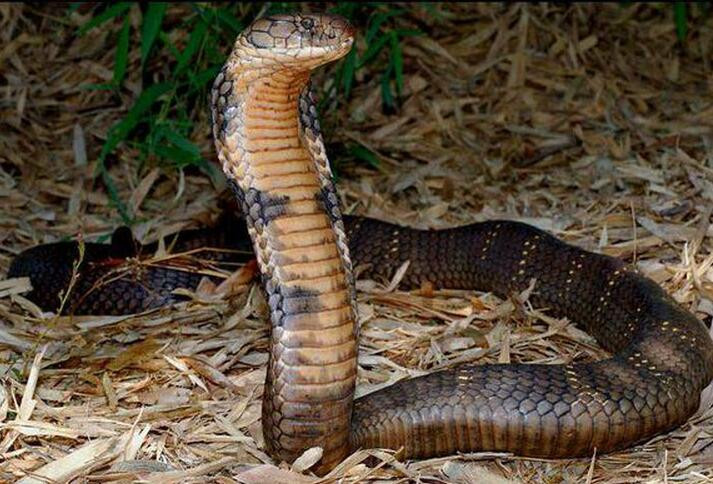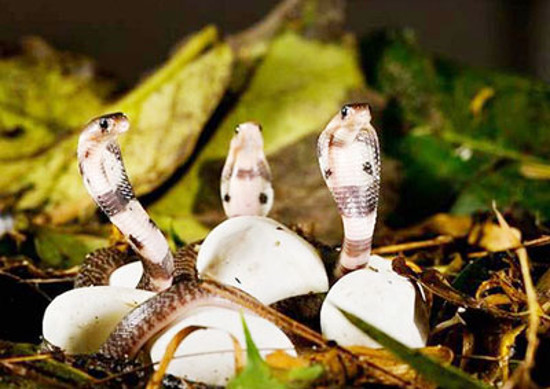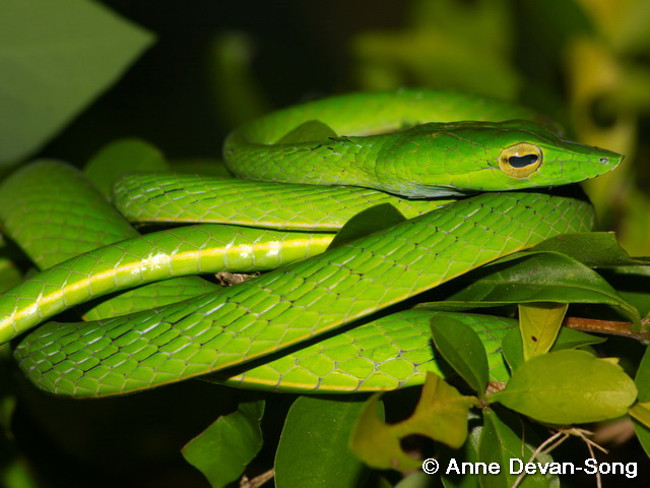'Snake kingdom', where snakes go back into flocks in Vietnam
Phong Nha - Ke Bang National Park (Quang Binh) is world-famous for its world-class cave system. It is also home to more than 150 species of snakes, accounting for more than half of the number of snakes in Vietnam. Among them are many species of snakes, many strange and dangerous snakes, such as three-edged serpent, king cobra, stork snake, .
This is really the kingdom of snakes. Because this is considered an ideal place for snake species to survive, hunt and make friends, solid density appears very much, especially at night. When entering any forest you can easily catch dozens of snakes.

Cobra with gods in the mountainous area of Phong Nha - Ke Bang.
The most dense place of solid density is probably the U Bo mountain forest area to the east of Phong Nha Ke Bang garden. According to forest rangers and forest goers, they have seen thousands of snakes crossing Ho Chi Minh Road to move from one forest to another.
In Phong Nha - Ke Bang, scientists have discovered many narrow endemic snakes. Scientist Thomas Ziegler has discovered new snakes here such as green snake-backed burrs (Triceratolepidophis sieversorum - 2000), An-ri-ri snake (Amphiesma andreae), Tomorrow's snakes (Calamaria thanhi - year 2005), ball lizard (Lygosoma boehmei - 2006), Smithi cheek snake (Fimbrios smithi) .
King Cobra - King of snakes
In Phong Nha - Ke Bang is home to the king cobra species called the king of snakes . The weapon of the king cobra is the venom that can kill even a giant elephant. They are "cold-blooded assassins" who eat all other snakes, even snakes of the same species.
When mating is finished, children must "flee" really fast or they will be turned out to eat by their "lover".
Nesting season, this snake knows how to avoid flooding very smartly. The cobra carries the wood to find many bamboo trees, then it uses the body to wrap each dry leaf dune into a nest with a foot diameter of 2m wide, up to 1m high, it crawls into the middle, creating a small nest and laying egg. Each litter usually lays 34 to 40 eggs. After hatching the eggs for about 3 months, the mother snakes away from the nest and leaves. Because they fear themselves will kill the cubs. Then the eggs will hatch into small snakes.

The newly hatched cobra.
Waiting for them ahead is extremely harsh survival battles. Lots of hatchlings rarely live fully and often die a lot by snakes or larger cobra.
Adult cobra snakes are usually up to 5 meters long and have a lifespan of more than 30 years.
Stork snakes - Cruel snake for you
Antiquated snake named Ahaetullaprasina is a very special snake. The reason for this snake's name is the stork snake's neck is because of its head like a stork head. After laying eggs, this snake died right next to it. There is a theory that the mother snake is secretive to make food for the snake that will hatch about 20 days later. Some other opinions suggest that due to exhaustion of the mother snake during childbirth, she died.
But all are unconfirmed and this is still a mystery so far that scientists still have a headache.

There are still many strange snakes yet discovered in the kingdom of Phong Nha - Ke Bang snakes because humans have not yet set foot to discover all this vast and mysterious vast land.
Many snakes in Phong Nha - Ke Bang have "set foot" for famous zoological museums in many countries around the world like the National Museum of Natural History Paris, France (MNHN); Museum of Natural History Geneva, Switzerland (MHNG); Russian Academy of Sciences, Animal Institute (ZISP), St. Petersburg, Russia .
You should read it
- At the end of the battle of death, the poisonous tiger was swallowed by the king's snake
- Identify poisonous snakes in Vietnam
- Jade snake snake - Beauty queen snake in Vietnam
- Discover new snake species in Con Dao
- I have the unique venom in the world of snakes, the sea snakes are eating again and again in a moment
- There are 50 venomous snakes, this is the most unique snake on the planet
- The most venomous snake in Vietnam, the king cobra is still far behind
- The horrifying secret about the scary 'cold blood assassin' in nature is revealed
- Brown snakes survived miraculously after being swallowed by the black snake and then released
- The civet jumps and pulls the poisonous serpent corpse on the tree to eat meat
- The duel between snakes and woodpeckers
- Cobra snakes its head in a beer can and an unexpected ending






 Jade snake snake - Beauty queen snake in Vietnam
Jade snake snake - Beauty queen snake in Vietnam The most venomous snake in Vietnam, the king cobra is still far behind
The most venomous snake in Vietnam, the king cobra is still far behind Identify poisonous snakes in Vietnam
Identify poisonous snakes in Vietnam I have the unique venom in the world of snakes, the sea snakes are eating again and again in a moment
I have the unique venom in the world of snakes, the sea snakes are eating again and again in a moment Brown snakes survived miraculously after being swallowed by the black snake and then released
Brown snakes survived miraculously after being swallowed by the black snake and then released There are 50 venomous snakes, this is the most unique snake on the planet
There are 50 venomous snakes, this is the most unique snake on the planet